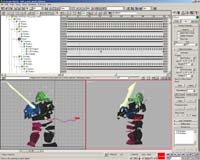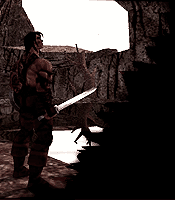|
3d Artist: Javier Rollón Morán
Before becoming a part of RAS I was in the TV industry making some
3D advertisements with Alias power Animator, and later, animations
for the Cheshire cat from Alice in Wonderland for DisneyQuest in
a company called SiliconArtist; as some internet stuff (web pages,
VRML, etc.). Before getting into RAS I got in touch with video game
developers in Spain (PyroStudios and RAS), and in the rest of the
world (Westwood,Electronic Arts,...); all of these made via internet.
I made some tests before getting inside, and now I am another member
of 18 people, working hard on developing one of the better games
ever seen on the screens.
This is the way we work in 3D Studio Max 2. I like this layout;
3 Windows: The upper one is the track view and lets us easily see
where the keyframes are. The dots are the keyframe of every object
of the body, and as you can see they are only in the rotation field
(The center object, also motion field). The keyframes are the position
(in this case an angle) of the object in one moment of an animation.
For most animations we put a frame rate of 20 frames per second
(From 0 to 20 represents 1 second of movement, from 0 to 40, 2 seconds....).
The Black lines are only markers to make an easy way of moving those
keys.
 The
bottom ones is the 3d-views, and we always put the left (or right)
and front views of the model in this 3d-view. RAS have made some
plugins for MAX, not for working but for exporting animations, models
or importing maps (to take reference where our characters are putting
the feet). The
bottom ones is the 3d-views, and we always put the left (or right)
and front views of the model in this 3d-view. RAS have made some
plugins for MAX, not for working but for exporting animations, models
or importing maps (to take reference where our characters are putting
the feet).
The most time consuming part, is animating a model. Making a model
takes two weeks, while animating it can take 2 moths. In this game,
nowadays we have 1500 animations so, making them all by hand is
a huge work to do. That is why we chose the motion capture system,
as well as the feeling it gives to an animation, making it more
realistic.
When a model is finished, we make the skeleton of that model. This
skeleton defines the form for the pieces that cannot be deformed.
You can see these pieces in the picture when you look at the Dwarf,
and you can see that there are other faces that are not there. The
engine draws these faces later. The visible pieces are linked to
each other forming a tree, where its parent is the center of the
body, and the children are the head, hands and feet. The body of
the model consists of 25 parts, and two parts for the swords. We
use two parts for the swords because they guide us in fitting both
the hands well.
Later, we go to a motion capture studio where an actor put a suit
with a lot of ball-markers, and 10 cameras record all his movement.
With a plug-in for 3DStudio Max, made by Angel Cuñado, we
import this movement file into the main character (in this case,
the Dwarf). From this point we have two types of movement: looping
movements (walking, running, relax...) and non-looping (deaths,
strikes, jumps...).
In RAS we have to make them loop-able and clean the imperfections
in the movement. Some times, when Jose Luis Vaello (Art Director)
doesn't likes a movement, we have to correct them, and sometimes
it's better to make it by hand completely, than try to use that
motion capture movement. There are also enemies that cannot be done
by motion capture: Birds, Wyverns, spiders, demons and other monsters
that I cannot tell (surprise...heh)
Sometimes, other models can share an animation if they have the
same body proportions. If not, we have to convert that animation
to the others. For example: in one hand weapon movements, that movement
don't depend in the type of sword the character has, its always
the same, and some movements of the Barbarian (one hand movements)
are shared with the Dwarf, or Amazon. But in our game each character
has a speciality: The Knight is expert in the usage of one handed
swords, so he is the only owner of a special set of animation and
combos. The Barbarian is the only one that can make well movement
with swords held by both hands, etc. What happens if I choose the
Dwarf (it's my favorite. Looks funny), and I find a DeathSword (name
of the weapon in the picture)? I can carry it, but when I hit the
fire button, it doesn't show a well-done movement, it makes a sluggish
movement. That is the attack in the picture. That's why it is called
"Dwf_g_bad_sword".
The yellow lines form the connection between parents and children
in the link hierarchy. The "+" is the pivot of each object,
and is where each object can be rotate around. All objects can only
have rotation keyframes except the center one that can also have
moment keys. The yellow lines are only visual helpers in Max.
From the beginning of my work here in RAS, the only work I have
done is animation. Well, at the end of the game I am taking part
of the model of some characters in the game, in high polygon count
for marketing. Luis Miguel Quijada and Daniel Delgado are the people
who have modeled most of the enemies and characters. Daniel has
been here from the beginning of Blade and he has done both modeling
and animating. Luis Miguel modeled the Dwarf.
The right panel is the Inverse Kinematics (IK) menu. IK is a way
of moving objects in hierarchies. When I apply IK and I move a foot,
the parents of that foot moves accordingly, until the parent stops,
by putting a Terminator modifier to it (in the right panel). Imagine
that you have a character in a relax movement, and his leg come
out bad and introduce it into ground. How do you fix this? Easy!
Using that panel I put the numbers of the start and end of the animation
where you want the leg to stay in place. Mark the center as a Terminator,
and the foot as Bind Position and Bind Orientation. Then press the
Apply IK button, and it's fixed!!! Bind means to make an object
stay in place and orientation
When we finished the movement in MAX (or think that we have end
the movement), we export the movement to the game, and test it.
Now we have Direct3D and OpenGL, but before we needed two monitors
to put it into Glide.
The blue line, with the red boxes, is showing the line of motion
for an object. The boxes are measuring the amount of time between
the frames. The boxes are only shown for the motion keys, none for
the rotation keys; each box is put in every key of the animation
(20 keys, 20 boxes), and when a lot of boxes are together then the
movement is slower. Sometimes, if we have 100 frames with 2 keys,
one at the 0 frame and the other at the 100, but the position is
very different, the animation can be slowly. It is a great help
for us to make the movement smoother.
Normally we don't work in shaded mode. We use wireframe mode (it's
quickly), but we use the shade mode to see that none of the body
parts move inside other parts of the body.
As an anecdote must say that when we were in Sheffield making motion
capture, the actor was ill. So I had to put on the balls (mocap
equipment), and made all the sets of motions of the Minotaur (bull
look-alike creature), so when you'll see a Minotaur in the game,
you see me. You see: Spain = Bulls; It's our destiny, heh.
Previous
| Index | Next
|





